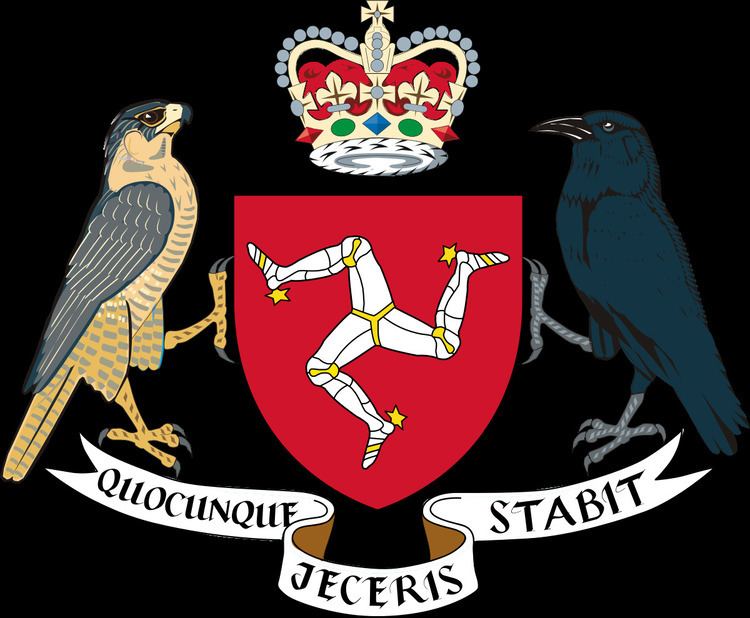Adopted 12 July 1996 | ||
 | ||
Escutcheon Gules a triskele argent garnished and spurred or Motto Quocunque Jeceris Stabit | ||
The Coat of Arms of the Isle of Man dates from 12 July 1996. As the Isle of Man is a Crown dependency, the arms are more accurately described as the Arms of Her Majesty in right of the Isle of Man. The coat of arms—featuring a triskeles—is based upon the traditional coat of arms associated with island which first appears on record in the late thirteenth century. The origin of the triskeles is obscure but appears to stemmed from the Scottish takeover of the island at this point in history. The heraldic supporters are birds associated with the island, whilst the motto first appears on record in the seventeenth century.
Contents
Description
The coat of arms was granted by Elizabeth II, Lord of Mann, on 12 July 1996. The escutcheon is blazoned: gules a triskele argent garnished and spurred or. The crest is blazoned: an imperial crown proper. The supporters are blazoned: dexter a peregrine falcon and sinister a raven both proper. The motto is: Quocunque Jeceris Stabit.
The heraldic device of the triskele or triskeles has been associated with the Isle of Man for centuries. The supporters are symbolically associated with the island as well. In 1405, Henry IV, King of England gave the Isle of Man to John Stanley. The latter gave Henry two peregrine falcons, and was to provide the same to every future English king on his coronation. On the coronation of George III in 1822, the latter was presented with two falcons. The raven is a bird strongly associated with Norse mythology, and appears in numerous place names on the island.
The Latin motto Quocunque jeceris stabit can be translated as "whithersoever you throw it, it will stand", or "whichever way you throw, it will stand". The motto dates to the 17th century, when it is first recorded on Manx coinage dating to the year 1668.
Origin
The coat of arms is an augmented form of the traditional arms associated with the island. It is unknown when the triskeles was originally adopted as a symbol in a Manx context. It appears associated with the island in several late 13th-century armorials, such as Camden Roll, Herald's Roll, Segar's Roll, Walford's Roll, and Wijnbergen Roll (all of which date from 1270-1300). Just before this period in history, the island formed part of the Kingdom of the Isles, ruled by the Crovan dynasty. The last member of this ruling family died in 1265 without a legitimate heir. The island then passed into the possession of Alexander III, King of Scotland (died 1286). In 1266, sovereignty of the Isle of Man and the Hebrides was formally transferred from the Norwegian Crown to the Scottish Crown.
There is no evidence that the Crovan dynasty utilised the triskeles as a heraldic device. Instead, members of this family are known to have borne ships and lions on their seals. Although it is possible that the origin of the Manx triskeles lies in a knotted devicel depicted on the coinage of their 10th century Viking predecessors on the island, that particular device is dissimilar to the Manx triskeles, and the nearly 300 year gap between its use and the appearance of the Manx triskeles suggests that there is no connection between the symbols.
The appearance of the triskeles in the last third of the 13th century may well be connected with the regime change on the island in 1265. The symbol is otherwise closely associated with Sicily, and is attested there as early as the 7th century BC. In 1250, Frederick II, Holy Roman Emperor, died after having ruled Sicily for 52 years. Four years later, the papal legate invested the Sicilian kingship in Edmund (died 1296), the young son of Henry III, King of England (died 1272), and for about ten years afterwards Edmund was styled "King of Sicily". Alexander III's wife, Margaret (died 1275), was a daughter of Henry. This familial connection between the English and Scottish royal families could account for the introduction of the triskeles as a symbol of the Isle of Man. If so, it could well have been adopted as a means to reinforce the regime change on the island. Although there is no evidence that the triskeles was used on Sicily itself in the 13th century, there is architectural evidence of its use in Austria at that time. Such evidence is almost certainly associated with Frederick himself, and almost certainly stems from his Sicilian connections.
